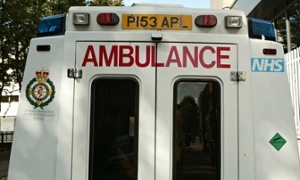
Staff members from the London Ambulance Service are not shy about why they’re at Melbourne’s Crown Plaza hotel to speak to about 50 soon-to-be graduate Victorian paramedics.
Walking around the room, words like “poaching” and “nicking” can be heard, as London paramedics speak to Australian students about what working for the busiest emergency service in the European Union entails.
It’s the second time London recruiters have come to Australia, having employed 175 Australian graduate paramedics in September last year, the bulk of whom came from Victoria and New South Wales.
This time, they’re aiming to make 250 job offers to Australians, before coming back in September in search for a further 250 recruits. A similar information session will be held in Sydney next week.
London Ambulance Service director of operations Jason Killens says “it’s no secret” the UK had been plagued by paramedic shortages in recent years. There were 2,000 paramedic vacancies across the UK, 400 of which fell within the London Ambulance Service’s responsibility, almost 1,000 square kms of London and Greater London, he said.
“The universities have been asked to increase places in the course from 150 to 500 places each year, but because it’s a three-year program, there’s a lag,” Killens said. “So this is a short-to-medium term solution for us, which helps us to continue to deliver high quality care in London using graduates who undergo very similar training to ours.”
So desperate was the London Ambulance Service to fill positions that about 50 graduates recruited last year were offered a bonus of more than $9,000 if they were prepared to fast-track their move to London to begin training in January this year.
Graduates are offered a permanent contract and are offered visa sponsorship, if needed, for three years with the opportunity to extend, and are given a salary of $60,000 to $76,000, as well as a supplement for living in a high-cost area if employed in central London.
This salary was “broadly comparable” to Australian graduate pay, Killens said, though pay rates and conditions for paramedics differ across states and territories.
According to the salary comparison website PayScale, the average wage for a graduate paramedic in Australia was $59,246 per year. However, Victorian paramedics are the lowest paid in the country, and negotiations for a new enterprise bargaining agreement are currently underway with the state government.
Glenda Millar, 29, said she attended the London Ambulance Service information session on Wednesday night to keep her options open.
“At the beginning of our course we were told it was a degree with a guaranteed job at the end of it, but now we are towards the end we are hearing people accepted by the service last year are still waiting for positions to become available,” she said. “I think working in London would expose me to a wide range of new experiences in a really busy environment, so I think it would be a great opportunity for a graduate.”
Australian recruits undergo almost four months of “conversion training” if they go to the UK. It includes learning how to operate UK vehicles, how to respond to emergencies in London’s underground railway network, and how to administer drugs not used by Australian paramedics.
All this costs money, but it’s still worth it to the UK recruiters.
“It costs £50,000 [$98,000] to train one paramedic back home, so when we recruited 175 Australians last year we saved about £9m in training fees,” Killens said.
Guardian Australia has requested comment from the Victorian health minister, Jill Hennessy, about the government’s response to the recruiting of Australian-trained staff, but had not received a reply at the time of publishing.
About 50 Victorian student paramedics turned up to ask questions of Killens and his team on Wednesday night.
“Do we get to choose which part of London we work in?” someone asks.
The answer was yes, where possible placement requests are accommodated for, clinical team leader Kier McLean said.
When asked about the biggest adjustment for Australians working with the service in London, McLean responded: “The weather.”
“That, and we get between 5,000 and 6,000 calls every day,” he said. “We’re an incredibly busy service and from the moment you start work, you will get called to somewhere straight away. It’s very hard work.”
Unit Coordinator for the Bachelor of Emergency Health (Paramedic) at Monash University, Linda Ross, said nine of her former students were now working for the London Ambulance Service.
It was something she encouraged.
“I think it’s too early to say how they’re doing because they’re just completing their conversion training, but they send me photos of their travels and in their new uniforms and seem to be making the most of the experience,” she said.
“It is a fantastic opportunity to broaden their horizons and get experience, and if they come back to Australia with that experience I think they will be very attractive to Ambulance Victoria.”
The Assistant Secretary of the Victorian branch of Ambulance Employees Australia, Danny Hill, said he believed London’s eagerness to poach Australian staff was something to be embraced.
“We see it as recognition of the high level of standards Victorian paramedics have, and while they are recruiting from Australia and New Zealand, my understanding is they have a real focus on Victorian and NSW paramedics,” he said.
“We know some of our members are interested in them for a variety of reasons, whether it’s conditions, wages, or they just want a change of scene.”
